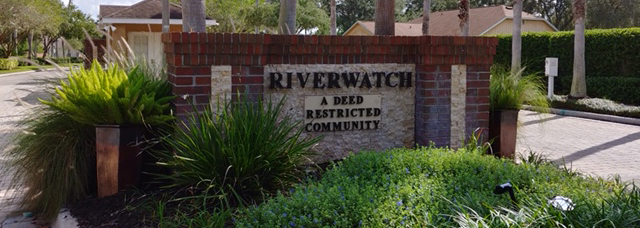The Covenants for River Watch clearly state that “all homeowners shall maintain their properties in good repair”. These guidelines provide an outline of what is meant by “good repair”. It is NOT a checklist, but rather a series of examples and guidelines that a homeowner can use to determine what the Homeowners’ Association, and our fellow homeowners, can expect from each of us in the way of home maintenance.
1. Homes:
Problem: Poorly Maintained or Unmaintained Houses
Problem Definition: Any house that has fallen into general disrepair such as; Rotten, decayed or corroded siding, trim, doors or garage doors. Broken windows. Broken or inoperable (always left open) doors. Missing or loose shingles. Unchecked moss or mildew growth on the building or the roof. Holes, gaps or openings in the siding or foundation that may harbor rodents, snakes or other vermin. Cracks or gaps in stucco surfaces exceeding _” width and/or 2 ft in length. Unchecked accumulations of wasp nests. Paint, siding or trim colors that have faded, chipped or discolored to the point that the house is no longer of a uniform color. Broken or rusted external equipment such as A/C units, water softeners, or pool equipment. Torn or missing panels on visible portions of screen enclosures. Sagging or damaged gutters.
2. Lawns:
Problem: Uncut grass
Problem Definition: Any lawn that exceeds 6” in depth for more than 2 weeks is considered a problem.
Problem: Dead Grass
Problem Definition: When approximately 20% or more of the visible portion of a properties lawn is dead or diseased and no attempt at corrective action is taken for 60 days or more.
Problem: Unkempt Lawn
Problem Definition: When a lawn is permitted to grow unchecked without regular maintenance. Some examples are: Lack of edging along sidewalks or streets which results in the grass overgrowing the pavements by several inches; Lack of edging around structures; Allowing lawns to overrun planting beds; Permitting excessive weeds to overtake the turfgrass.
3. Trees, shrubs, planting beds:
Problem: Dead Plants
Problem Definition: When approximately 25% or more of plants in a bed are dead or obviously diseased and no corrective action is taken for 60 days or more.
Problem: Unmaintained Planting Beds
Problem Definition: Planting beds that become overgrown with weeds or grass; or where plants have been allowed to grow unchecked. Plants and shrubs should not be allowed to grow such that they obstruct windows or walkways, sidewalks, driveways or property identification markers.
Problem: Unmaintained Trees or Shrubs
Problem definition: Trees that are obviously dead (no leaves or growth) for 4 months or more. Trees that overhang streets or sidewalks which are not trimmed to provide at least 8 ft vertical clearance.
4. Fences:
Problem: Poorly Maintained or Unmaintained Fences
Problem Definition: When fences are allowed to deteriorate. Examples include fences out of plumb (vertical) by more than 2” over 6’. Individual boards or slats that have warped or cupped more than 2” out of the plane of the fence. Individual boards or slats that have split or broken where the pieces are loose or pose a hazard. Posts that have warped or cupped to a point where the fence is more than 2” out of line or plumb. Posts that have rotted such that they are no longer able to support the fence. Individual boards or slats that are rotten or decayed such that they are no longer sound. Gates that are missing, or sagging, or do not operate properly.
5. Sidewalks & Driveways:
Problem: Poorly Maintained Driveways or Sidewalks
Problem Definition: Any driveway or sidewalk that has spalled (surface of the concrete has popped off). Excessive cracks such that the concrete is no longer structurally sound. Large cracks wider than _” at any point. Settled concrete, any sidewalk or driveway that has settled out of its original elevation more than 1/2”. Concrete must be free of oil stains, rust spots, or other stains.
6. Sheds & Out Buildings:
Problem: Poorly Maintained Sheds & Outbuildings
Problem Definition: Any shed or outbuilding that has fallen into general disrepair such as: Rotten, decayed or corroded siding, trim or doors. Broken windows. Broken or inoperable (always left open) doors. Missing shingles. Unchecked moss or mildew growth on the building. On metal buildings, severely dented siding or multiple small dents. Rotten, decayed or settled building foundations such that the building is no longer securely supported or has shifted out of level by more than 2” over 8’. Holes, gaps or openings in the siding or foundation that may harbor rodents, snakes or other vermin. Unchecked accumulations of wasp nests. Paint, siding or trim colors that have faded or discolored to the point that the shed or outbuilding no longer matches the main home of the property. Excessive use of exterior storage features. (Items are not to be stored outside the structure unless screened from view.)
7. Mailboxes:
Problem: Poorly Maintained or Broken Mailboxes
Problem Definition: Any mailbox that has visible mildew, has discolored or broken components, or missing door. Mailbox posts that are out of plumb more than 2”. Posts that are rotted or have excessive cracks (wider than _”). House identification numbers loose or missing from the mailbox post or not visible due to unchecked growth of surrounding plants.
